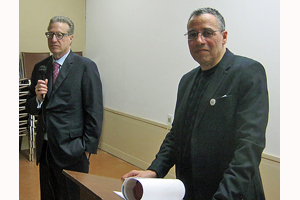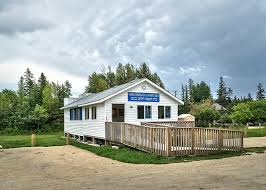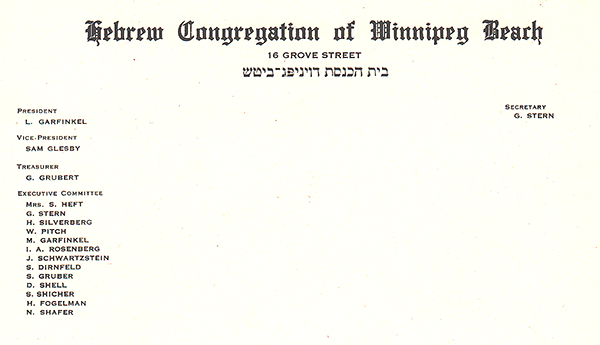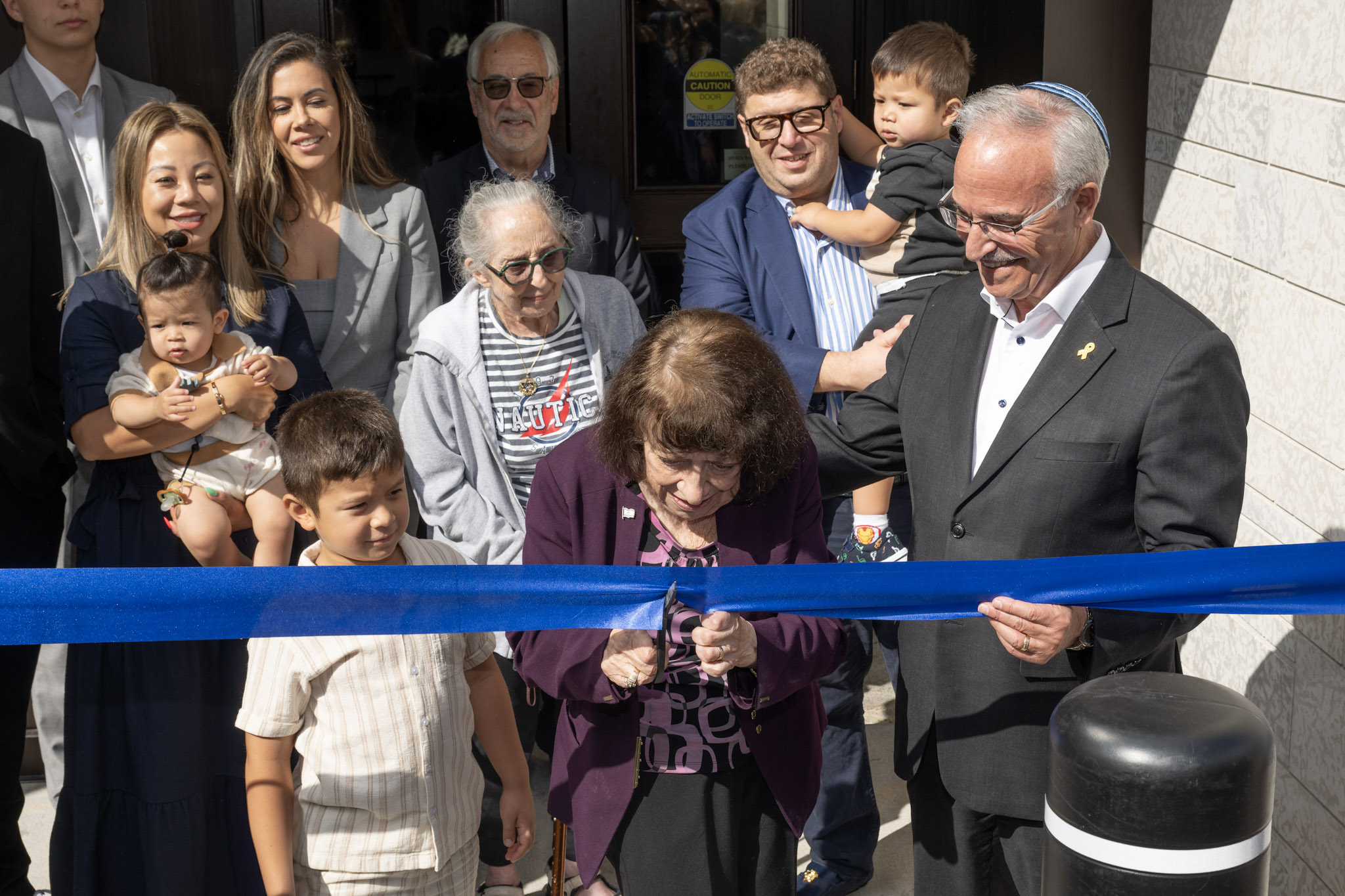Local News
Arab Jewish Dialogue emphasizes respectful discussion of differing points of view

By MYRON LOVE
Fourteen years ago, Egyptian-born Winnipeg businessman Ab Freig and the late Harold Buchwald found themselves to be fellow members of the board of the Arthur V. Mauro Institute for Peace and Justice at St. Paul’s College, University of Manitoba. Freig at the time was also involved in the Peace Action Network through which he had learned of a number of dialogue groups in operation, a concept he thought might be of benefit in Winnipeg as well. He approached Buchwald and proposed that they start an Arab Jewish Dialogue group in Winnipeg – with Freig recruiting the other Arab members and Buchwald bringing in Jewish representation.
According to an analysis in a report in the Canadian Jewish News, he points out, Winnipeg’s Arab Jewish Dialogue (AJD) is the only such group that has proven successful.
On Tuesday, February 25, speaking at a Winnipeg Friends of Israel program at Temple Shalom, Freig and his Arab Jewish Dialogue co-chair, Howard Morry (who stepped in for Harold Buchwald after his passing), delved into the history of the AJD and some of the challenges.
“We are not involved in interfaith dialogue,” Morry stated. “Our vision was to forge on person to person relationships with a focus on the Israel-Palestinian situation. Our ground rules are that discussion has to be respectful while each side attempts to explain their point of view.”
Morry added that people with extremist views are not welcome.
Freig chipped in that “we are not in this to change minds. Rather, we try to understand each other and educate one another about issues that we hold dear to our hearts”.
Morry cited one instance when the Dialogue almost came to an acrimonious end. That was in 2008 in the midst of Israel’s “Operation Cats Lead” mini war with Hamas in Gaza sparked by Hamas firing rockets into Israel. “The Jewish members of AJD are generally liberal in their views,” he said. “We didn’t see anything controversial in Israel responding to prolonged rocket fire. But the Arab members were getting very emotional. They were belittling the missiles – comparing them to firecrackers. The meeting ended early and the next scheduled meeting was cancelled to let things calm down.”
At the next meeting, Morry, speaking for the Jewish members, acknowledged feeling bad about the loss of life on both sides. “Then was what our Arab friends wanted to hear,” he recalls. “After that, discussion resumed and our Arab members came down harder in Hamas than we did.”
The major divide between the AJD Arab and Jewish members, Freig noted, revolves around Zionism. “All of our Arab members grew up in Middle Eastern countries where they were taught that Zionism is an expansionist ideology,” he noted. “Most of us still listen to Arab media. To most of the AJD Arab members, Zionism is a “dirty“ word.”
Morry noted that it took three to four years before he found a way to explain Zionism that made sense to his Arab colleagues. “The problem is that the Arabs view Jews as a religious minority rather than as a people with our own culture and homeland as well as religious practices and beliefs,” he explained.
He compared Israel as a nation-state to Italy and Germany which only became nation – states in 1870 – just eight decades before Israel. Like Israel, Italy and Germany are homelands for distinct ethnic groups but also minority populations. As well, for both Italians and Germans, there are a great many more ethnic Italians and Germans living outside of their homelands than in them.
“Israel as a country is a lot more normal than many people may think,” Morry observed.
“The nub of the problem,” he pointed out, “is that Israel’s neighbours have never been willing to recognize Jews as a people with an ancestral homeland.
Hamas’ oft-stated goal is to “liberate” all of the land of Israel, Morry noted. The PLO (Palestinian Liberation Organization), the representatives of the Palestinian People in the eyes of the world, shares the same goal but is willing to negotiate for the land piece by piece.
On the subject of President Trump’s “Deal of the Century”, Morry and Freig expressed some disagreement. Freig spoke about putting oneself in the other’s shoes and fairness. He spoke of “fairness” and Palestinian rights. He also suggested that Israel keeps moving the goalposts.
Morry observed that Trump’s plan has two sides to it. On the one hand, the Israelis are being offered everything they could possibly want and more – control of Jerusalem, the Jordan Valley and the Jewish communities in Judea and Samaria – in return for which Israel must recognize the Palestinian States (which this writer argues Israel already does in a virtual sense if not officially).
The Palestinian State would be encompass the area that the Palestinian Authority currently administers in Judea and Samaria as well as Gaza and Israel would cede some Israeli land in the Galilee and the Negev to the Palestine. The Palestinians would also be eligible for up to $50 billion in economic development funding. The Palestinian leadership though would first have to recognize Israel as a Jewish state, denounce terrorism and agree to demilitarization.
There are two factors here though that makes it impossible for the Paletinian leadership to accept the proposals. The one not addressed by either Morry or Freig. That is that there are two competing factions – Hamas and the PA – who control Gaza and the Palestinian lands in Judea and Samaria. They hate each other as much – or more – than they hate Israel and will never agree on compromise. So there is no one voice speaking for the Palestinians.
The other factor is that which Morry alluded to earlier – that the Palestinian leadership has consistently refused to recognize Israel as the homeland of the Jewish People. They deny any historical connection between Jews and the land of Israel.
Both Freig and Morry agree that the final decision should be made by the Palestinian People as a whole. But – in this writer’s view – that is not going to happen as long as the Palestinian People live under the rule of not one – but two Palestinians dictatorships – Hamas in Gaza and the PA in Judea and Samaria – and have no right of freedom of speech.
Local News
Thank you to the community from the Chesed Shel Emes

We’re delighted to share a major milestone in our Capital Campaign, “Building on our Tradition.” Launched in November 2018, this campaign aimed to replace our outdated facility with a modern space tailored to our unique needs. Our new building is designed with ritual at its core, featuring ample preparation space, Shomer space, and storage, creating a warm and welcoming environment for our community during times of need.
We’re grateful to the nearly 1,000 generous donors who contributed over $4 million towards our new facility. A $750,000 mortgage will be retired in November 2025, completing this monumental project in just seven years.
We’re also thrilled to announce that our Chesed Shel Emes Endowment Fund has grown tenfold, from $15,000 to $150,000, thanks to you, the Jewish Foundation of Manitoba’s FundMatch program, and Million Dollar Match initiative in 2024. Our fund helps ensure that everyone can have a dignified Jewish funeral regardless of financial need.
As we look to the future, our goal remains to ensure the Chevra Kadisha continues to serve our community for generations to come. Our focus now shifts to replenishing our savings account and growing our JFM Endowment fund.
We’re deeply grateful for your support over the past several years.
It’s our privilege to serve our community with care and compassion.
With sincere appreciation,
Campaign cabinet: Hillel Kravetsky, Gerry Pritchard, Stuart Pudavick,
Jack Solomon, and Rena Boroditsky
Murray S. Greenfield, President
Local News
Winnipeg Beach Synagogue about to celebrate 75th anniversary

By BERNIE BELLAN (July 13) In 1950 a group of cottage owners at Winnipeg Beach took it upon themselves to relocate a one-room schoolhouse that was in the Beausejour area to Winnipeg Beach where it became the beach synagogue at the corner of Hazel and Grove.
There it stayed until 1998 when it was moved to its current location at Camp Massad.
On August 2nd members of the synagogue will be holding a 75th anniversary celebration.

As part of the celebration anyone who is a descendant or relative of any of the original members of the first executive committee (as seen in the photo here) is invited to attend the synagogue that morning.
If you are a relative please contact Abe Borzykowski at wpgbeachshule@shaw.ca or aborzykowski@shaw.ca to let Abe know you might be attending or for more information about the 75th anniversary celebration.
We will soon be publishing a story about the history of the beach synagogue, which is something I’ve been writing about for over 25 years.
Local News
Vickar Family cuts ribbon on new Tova Vickar and Family Childcare Centre

By MYRON LOVE In the words of Larry Vickar, the Shaarey Zedek’s successful Dor V’ Dor Campaign “is not only a renewal of the synagogue but truly a renewal movement of Jewish life in our community.”An integral part of that renewal movement was the creation of a daycare centre within the expanded synagogue. On Monday, June 23, Larry and Tova Vickar cut the ribbon, thereby officially opening the Tova Vickar and Family Childcare Centre in the presence of 100 of their family members, friends and other supporters of the project.
The short program preceding the morning ribbon-cutting began with a continental breakfast followed by a welcome by both Fanny Levy, Shaarey Zedek’s Board President, and Executive Director Dr. Rena Secter Elbaze. In Elbaze’s remarks, she noted that Larry and Tova wanted their family (including son Stephen and family, who flew in from Florida) and friends at the event to celebrate the opening of the Tova Vickar and Family Childcare Centre, “not because of the accolades, but because, as Larry put it, he hopes that their investment in the congregation will inspire others to do the same.”
“When Larry and I spoke about what this gift meant to him and the message he wanted people to take away,” she continued, “I couldn’t help but connect it to the teachings of Reb Zalman Schachter-Shalomi whose book – Age-ing to Sage-ing – changes the whole way we look at the concept of ageing and basing it on our ancestral teachings.”
She explained that his concept of “Sage-ing” is based on three key ideas – Discover your meaning and purpose; accept our mortality and think about the legacy you want to leave.
“Larry spoke about these exact concepts when we met,” she said.
Elbaze also noted the presence of Shaarey Zedek’s newly-arrived senior Rabbi Carnie Rose, former Rabbi Alan Green, and area MLAs Mike Moroz and Carla Compton.
Larry Vickar expressed his great appreciation for all those in attendance. “Tova and I are deeply moved to stand here with you today for this important milestone in our community”, he said. “We are grateful to be surrounded by all of you, the people we care about, our family and friends… you who have touched our lives and played some part in our journey.”
